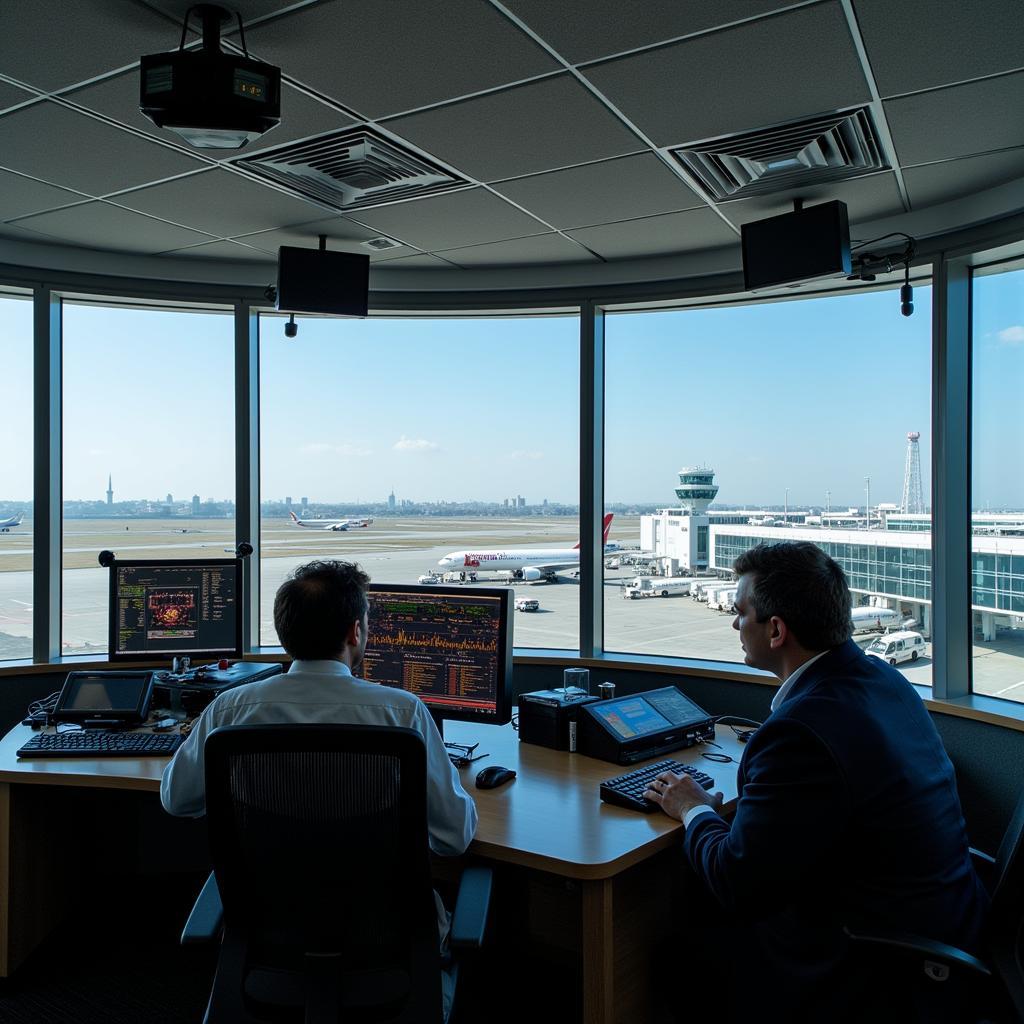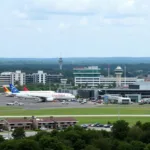Abu Dhabi Gal Airport Navigation plays a vital role in ensuring the safe and efficient flow of aircraft in and out of one of the busiest airspaces in the world. This intricate system relies on cutting-edge technology and skilled air traffic controllers to guide aircraft through every stage of their journey, from takeoff to landing.
The Importance of Seamless Airport Navigation at Abu Dhabi GAL
 Air Traffic Control at Abu Dhabi GAL Airport
Air Traffic Control at Abu Dhabi GAL Airport
Imagine a symphony orchestra, with each instrument playing its part in perfect harmony. This is akin to how Abu Dhabi GAL Airport navigation functions, orchestrating the movements of countless aircraft, each on a unique flight path. The primary goal is to maintain safe separation between aircraft, prevent collisions, and ensure a smooth and orderly flow of traffic.
This is particularly crucial at Abu Dhabi GAL, a major international hub handling a massive influx of flights daily. Efficient airport navigation minimizes delays, optimizes runway usage, and contributes to the airport’s overall operational efficiency.
Key Components of Abu Dhabi GAL Airport Navigation
Abu Dhabi GAL Airport navigation is a complex ecosystem of interconnected systems, technologies, and highly trained personnel. Let’s delve into some of the key components:
Air Traffic Control (ATC)
At the heart of airport navigation lies the air traffic control system. Highly skilled air traffic controllers work tirelessly from the control tower and radar centers, guiding aircraft through every phase of flight. They use radar systems, communication equipment, and standardized procedures to monitor aircraft positions, issue clearances, and provide essential information to pilots.
Navigational Aids (NAVAIDs)
NAVAIDs are electronic systems strategically placed on the ground and in the air to provide aircraft with navigational information. Examples include:
- VOR (Very High Frequency Omnidirectional Range): Provides aircraft with their bearing relative to the station, allowing pilots to navigate on specific courses.
- DME (Distance Measuring Equipment): Works in conjunction with VOR to provide pilots with their distance from the VOR station.
- ILS (Instrument Landing System): A precision approach system that guides aircraft down to the runway during low visibility conditions.
Communication Systems
Effective communication is paramount in ensuring safe and efficient airport navigation. Pilots and air traffic controllers rely on VHF (Very High Frequency) radios for clear and concise communication. Data links, such as ACARS (Aircraft Communications Addressing and Reporting System), provide a text-based communication channel for transmitting flight plans, weather information, and other essential data.
Technological Advancements in Airport Navigation at Abu Dhabi GAL
Abu Dhabi GAL Airport continuously adopts the latest technological advancements to enhance its navigation capabilities. One notable example is the implementation of Performance-Based Navigation (PBN). PBN leverages precise aircraft positioning and navigation capabilities, allowing for more efficient flight routes and optimized descent profiles. This not only reduces flight times and fuel consumption but also minimizes noise pollution.
Challenges and Future Trends in Abu Dhabi GAL Airport Navigation
While Abu Dhabi GAL Airport navigation operates at a high standard, it faces ongoing challenges, including increasing air traffic demand, the integration of unmanned aerial vehicles (UAVs), and the need for even greater sustainability.
To address these challenges, the aviation industry is actively researching and developing new technologies, such as:
- Next Generation Air Transportation System (NextGen): A comprehensive modernization program aimed at improving the efficiency, safety, and sustainability of air travel.
- Space-Based ADS-B: Utilizes satellites to track aircraft positions, providing global coverage and enhancing safety, particularly in remote areas.
- Artificial Intelligence (AI): AI-powered systems can assist air traffic controllers in managing increasingly complex airspace and predicting potential conflicts.
Conclusion
Abu Dhabi GAL Airport navigation is a marvel of modern technology and human expertise, working in unison to ensure the safe and efficient flow of air traffic. As technology continues to evolve, we can expect even greater levels of precision, efficiency, and sustainability in the realm of airport navigation.
FAQs about Abu Dhabi GAL Airport Navigation
1. What happens if an aircraft loses communication with air traffic control?
Aircraft are equipped with backup communication systems and established procedures to follow in case of communication failure. They would typically try to re-establish contact or follow pre-determined contingency plans.
2. How does Abu Dhabi GAL Airport handle bad weather conditions that affect visibility?
Abu Dhabi GAL Airport has advanced instrument landing systems (ILS) and other navigational aids that assist pilots in landing safely during low visibility conditions. Air traffic control also implements procedures to maintain safe separation between aircraft in such situations.
3. What is the role of pilots in airport navigation?
Pilots play a crucial role in airport navigation. They are responsible for planning and executing their flights, communicating with air traffic control, and monitoring their aircraft’s position and altitude using onboard navigation instruments.
4. How does Abu Dhabi GAL Airport manage noise pollution from aircraft?
Abu Dhabi GAL Airport implements noise abatement procedures, such as optimized flight paths and descent profiles, to minimize noise impact on surrounding communities. Airlines are also encouraged to operate quieter aircraft.
5. What are the future plans for improving Abu Dhabi GAL Airport navigation?
Abu Dhabi GAL Airport is committed to continuous improvement in its navigation capabilities. This includes investing in next-generation technologies, such as NextGen and space-based ADS-B, to enhance efficiency, safety, and sustainability.
For further information about Abu Dhabi GAL Airport navigation, you can also explore our articles on Abu Dhabi Gala Airport navigation services contract and Abu Dhabi airport view.
If you need assistance, please don’t hesitate to contact us. You can reach our 24/7 customer service team at +13089626264, email us at [email protected], or visit us at 404 Bothwell St, Oxford, NE 68967, USA.

